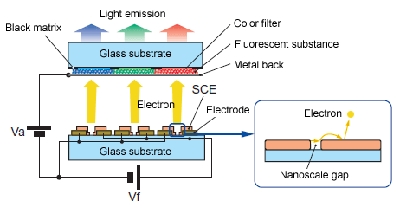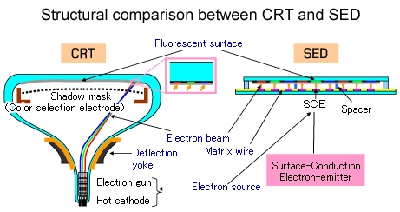SED: A New Player in the Flat-Panel Game Page 2
 An SED panel emits an individual electron beam for each color subpixel.
An SED panel emits an individual electron beam for each color subpixel.
What the two companies actually were showing was a 36-inch, 720p panel. Even making allowances for the fact that it was demonstrated in a nearly blacked-out room, the image it created was simply stunning in its lifelike contrast range (which was "only" 10,000:1, I was told). Deep blacks were as dark as the screen's black surround, not the extremely dark gray that you get, if you're lucky, with DLP, plasma, or LCD. The rapid response of the very tiny electron beams meant that edges and other sharp details remained clear and unblurred at all rates of motion. And the panel's thinness and independence from polarization effects meant that it remained watchable from far off axis, unlike many LCD panels. Many of the demo images were still photographs, and it was clear to me that a high-resolution SED screen may actually be the most lifelike way to view digital photographs. It was a letdown to emerge from the Canon and Toshiba demos into the real world of present-day displays, even the best of which didn't look as good (allowing for the inevitable differences in screen sizes).
So while I hate to throw a monkey wrench into your HDTV plans, if you are considering buying a flat-panel television in the next few months, you might want to hold on until the first reports on the Canon/Toshiba SED are in. The companies say that the 55-inch unit will be priced "comparably" to similar size flat panels based on other technologies. If that's the case, SED's CRT-like image quality and hang-on-the-wall form factor may make it the flat-panel technology of choice for critical viewers.
 Structurally, an SED is like a solid-state version of a cathode-ray tube.
Structurally, an SED is like a solid-state version of a cathode-ray tube.
Check out more CES news. Back to Homepage What's New on S&V
- Log in or register to post comments



































































